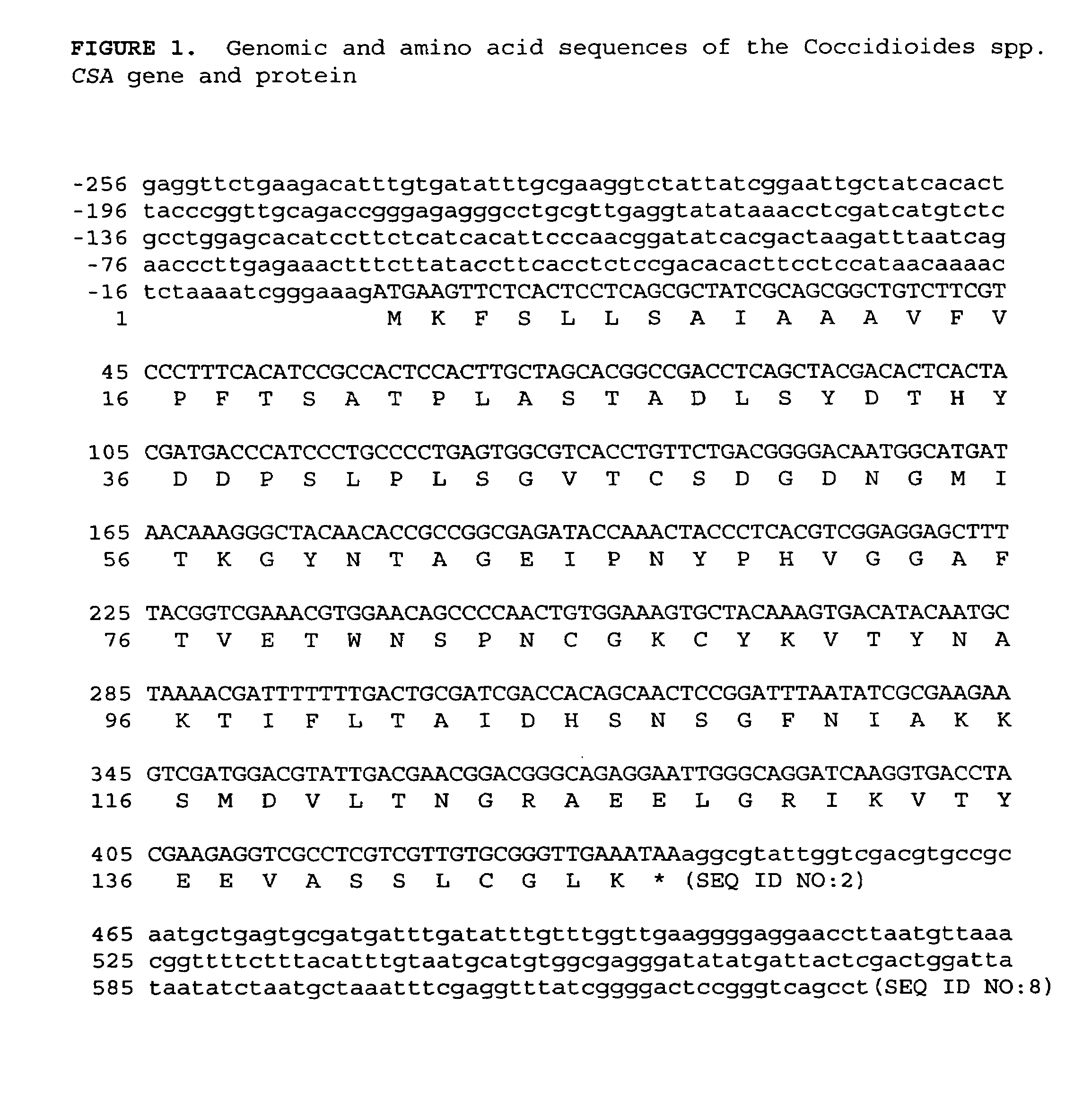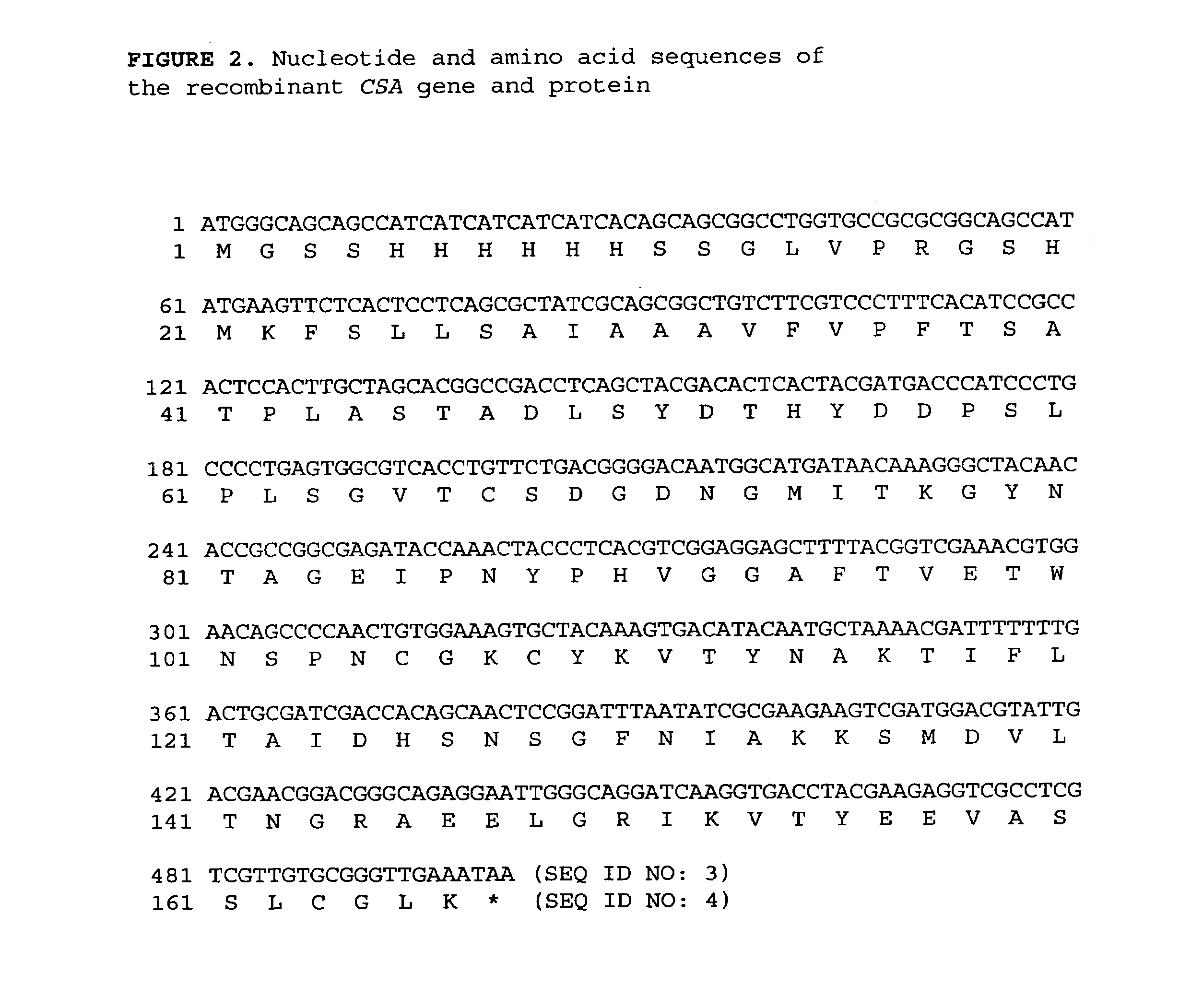Polypeptide and DNA immunization against Coccidioides spp. infections
- Summary
- Abstract
- Description
- Claims
- Application Information
AI Technical Summary
Benefits of technology
Problems solved by technology
Method used
Image
Examples
example 1
Cloning, Expression, and Characterization of rCsa
Materials and Methods
[0101]The CSA gene of C. posadasii (isolate C735) was first isolated from a genomic library constructed in lambda Fix II (Stratagene, San Diego, Calif.) using methods previously described (Wyckoff, E. E., Pishku, E. J., Kirkland, T. N. and Cole, G. T. 1995. Cloning and expression of a gene encoding a T-cell reactive protein from Coccidioides immitis: homology to 4-hydroxyphenylpyruvate dioxygenase and the mammalian F antigen. Gene 161:107-111), and was sequenced using the dideoxy chain termination method (Sanger, F., S. Nicklen, and A. R. Coulson. 1977. DNA sequencing with chain-terminating inhibitors. Proceedings National Academy of Science. USA 74:5463-5467) by denatured polyacrylamide gel separation using methods previously described (Pan, S., and G. T. Cole. 1995. Molecular and biochemical characterization of Coccidioides immitis-specific antigen. Infection and Immunity 63:3994-4002). The original genomic clon...
example 2
Fungal Burden Immunoprotection Studies
Materials and Methods
[0106]Culture conditions. C. immitis (strain RS) was used for all experimental procedures. Cultures were maintained on glucose-yeast extract agar, with arthroconidia prepared from the stock cultures.
[0107]Mice. Female, 6-8 week old C57BL / 6 mice were purchased from the Jackson Laboratories (Bar Harbor, Me.) and maintained in conventional housing in isolation units.
[0108]Immunization and challenge. Three separate experiments were performed. All experiments compared responses in mice immunized with rCsa to those injected with adjuvant control. In experiments 1 and 3, mice were immunized with 5 μg of rCsa plus 10 μg of ISS adjuvant (Trilink Biotechnologies, San Diego, Calif.) or 10 μg of ISS adjuvant as a negative control. In experiment 2, two groups of mice were immunized with either 1 μg or 5 μg rCsa plus ISS adjuvant and one group received ISS adjuvant control. All injections were administered intradermally at the base of the...
example 3
Survival Immunoprotection Studies
Materials and Methods
[0111]Culture conditions. C. posadasii (strain C735) was used for all experimental procedures. Stock cultures of the saprobic (mycelial) phase of the fungus were maintained on glucose-yeast extract plates (GYE, 1% glucose, 0.5% yeast extract, 2% agar) by culturing every 30 days. Arthroconidia (asexual reproductive products of the saprobic phase) were harvested from 4 week-old culture plates by passing a suspesion of the cells in sterile PBS solution through an autoclaved glass wool column to remove hyphal fragments. Concentration of viable arthroconidia was determined by dilution plating on GYE agar media.
[0112]Mice. Female, 6-week old C57BL / 6 mice were purchased from the National Cancer Instute (Bethesda, Md., USA) and maintained in conventional housing under microisolation lids. Mice were immunized one week after receipt. One week before infection, mice were moved to a Biosafety Level 3 laboratory where they remained for the du...
PUM
 Login to View More
Login to View More Abstract
Description
Claims
Application Information
 Login to View More
Login to View More - R&D
- Intellectual Property
- Life Sciences
- Materials
- Tech Scout
- Unparalleled Data Quality
- Higher Quality Content
- 60% Fewer Hallucinations
Browse by: Latest US Patents, China's latest patents, Technical Efficacy Thesaurus, Application Domain, Technology Topic, Popular Technical Reports.
© 2025 PatSnap. All rights reserved.Legal|Privacy policy|Modern Slavery Act Transparency Statement|Sitemap|About US| Contact US: help@patsnap.com


